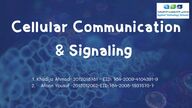
Return to flip book view
Message Cellular Communication& Signaling Khadija Ahmad- 2012018781 - EID: 784-2009-4104391-91.Afnan Yousuf -2012012062-EID:784-2008-1937575-72.
Introduction Cellular communication is how cells talk to each other and worktogether. It helps them sense what’s happening around themand respond in the right way. This is important for keeping thebody balanced, growing properly, fighting off germs, andhealing injuries. Without this kind of communication, cellswouldn’t be able to cooperate, and living things wouldn’tsurvive. Whether it's single cells in a colony or the manydifferent cells in the human body, communication helps them allstay connected and work as a team.Afnan yousef, 2012012062
Topic 1
chemical signaling direct contact 2 methods cells use to communicate Cells communicate through directcontact in these simple ways:Gap Junctions: Tiny channelsconnecting neighboring cells, allowingquick exchange of small molecules.1.Cell Surface Receptors: Proteins onone cell bind to molecules onanother, triggering a response.2.Direct Touch Signaling: Physicalcontact between cells activatessignals for example immune cellschecking for infections.3.Chemical signalling is how cells send messagesusing special molecules called signals or ligands.These signals help cells coordinate actions likegrowth, repair, and response to changes.Types of Chemical Signalling:1. Autocrine – A cell targets itself by releasingsignals that bind to its own receptors. Example: Tcells releasing interleukins to activatethemselves.2. Paracrine – Signals affect nearby cells,allowing local communication. Example: Nervecells releasing neurotransmitters like dopamine.3. Endocrine – Hormones travel through thebloodstream to reach distant cells. Example:Insulin from the pancreas regulates sugar inmuscle cells.Afnan yousef, 2012012062/Khadija Ahmed , 2012018781/Kpi’s 1.1 &1.2
Short distance vs Long distance Signaling Short-distance signaling occurs between nearby cells, often through directcontact or local chemical signals. It’s fast and specific but limited to asmall area.Long-distance signaling uses hormones or electrical signals to reachdistant cells in the bloodstream or nervous system. It takes longer butaffects multiple organs and tissues.Khadija Ahmad, 2012018781, KPI 1.3
how bacterial internal andexternal signals regulate avariety of physiological responsesBacteria regulate their physiological responses throughinternal and external signals to synchronize withenvironmental conditions, biological cycles, and cues.External signals like nutrient levels, temperature, or thepresence of other microbes are detected by sensoryproteins, while internal signals such as energy status orstress molecules reflect the cell’s internal state. Thesesignals trigger gene expression changes that adjustbacterial behavior. A key example is quorum sensing, wherebacteria release and detect signaling molecules calledautoinducers. When these reach a threshold concentration,indicating a high cell population, bacteria coordinateactivities like biofilm formation, virulence, orbioluminescence, aligning their functions with environmentaldemands and community behavior.Khadija Ahmad, 2012018781, KPI 1.4
cell-to-cell contact.Cell-to-cell interactions are when cells physically touchto send signals and work together. This helps withimportant tasks like growth, healing, and fightinginfections. These contacts are made using specialproteins on the surface of the cells.Example: T Cell and Antigen-Presenting Cell (APC)In the immune system, a T cell and an APC (like adendritic cell) interact to start an immune response:1. Recognition – The APC shows a piece of a germ(antigen) on its surface using a protein called MHC.2. Binding – The T cell receptor (TCR) binds to theantigen-MHC complex.3. Co-stimulation – Extra proteins like CD28 (on the Tcell) and B7 (on the APC) give a second signal.4. Activation – The T cell is now active and can multiplyand help fight the infection.5. This direct contact between immune cells is key toprotecting the body from disease.Afnan yousef, 2012012062, kpi’s 1.5
Endocrine signalling is a type of long-distance communication betweencells. In this process, hormones are made by endocrine glands andreleased into the bloodstream. These hormones travel through the bloodto reach target cells in different parts of the body, where they triggerspecific actions.Example: Testosterone1. Hormone Production Testosterone is mainly produced in the testes inmales, and in smaller amounts by the adrenal glands in both males andfemales.2. Release into Bloodstream Once it’s made, testosterone is released intothe blood, allowing it to move throughout the entire body.3. Reaching Target Cells Testosterone travels until it finds target cells—such as those in muscles, bones, or the brain—that have specialandrogen receptors.4. Hormone Binding Because testosterone is a steroid hormone (fat-based), it can pass through the cell membrane and bind to a receptorinside the cell.5. Cellular Response The hormone and receptor go into the nucleus, wherethey attach to DNA and turn on specific genes. This leads to physicalchanges like muscle growth, body hair development, and the formation ofmale reproductive organs.ENDOCRINE-SIGNALINGAfnan yousef, 2012012062, kpi’s 1.6
Cells talk to each other to stayhealthy, grow, and respond tochanges. They can communicate bytouching, sending signals nearby,or using hormones to reachfaraway cells. This helps the bodywork as one team. Even bacteriause signals to act together.Communication is key for life.ConclusionKhadija Ahmad,2012018781
Referenceshttps://doi.org/10.1016/j.cell.2006.04.001https://youtu.be/S0MYsrHx35E?si=OrpSKOBk20YI7KBAhttps://www.ncbi.nlm.nih.gov/books/NBK26926/